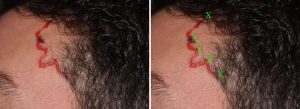The superficial temporal artery is one of the major arteries to the scalp. Its course is well known as it arises from the external carotid artery and extends superiorly in front of the ear as it heads further north. At a point at about 2 cms above and 1cm anterior to the ear, the superficial temporal artery splits into a Y becoming the anterior and posterior temporal branches. The anterior branch heads off at about 45 degrees towards the forehead where is does so in a very tortuous and serpeginous course. While often portrayed as a single branch, other anterior temporal branches can take off below the Y juncture.
Medically the superficial temporal artery is best known as being affected by giant cell arteritis. Determining this diagnosis is the historic reason for superficial temporal artery surgery by biopsy which is, in effect, a double ligation procedure so that an intervening arterial segment can be removed. More recently the superficial temporal artery has been implicated in specific types of migraine attacks and ligation has been offered as a treatment option in select patients.
The anterior branch of the superficial temporal artery can also have aesthetic implications as well. In some people, usually men, the artery can have considerable prominence which arises or is magnified by heat, exercise or anything that accelerates one’s heart rate. Arterial dilatation can cause a considerable prominence which can be aesthetically bothersome and is an uncommon form of temporal deformity. This appears as a very prominent vessel that arises in the non-hair bearing tenporal region to the side of the eye and extends variable distances into the forehead.

The incisions for anterior branch superficial temporal artery ligation only need to be about 5mms in length. They need to be big enough so the artery can be dissected and hooked where a suture is passed under it for ligation. In this technique a loop of the artery is actually brought out of the incision where it is easier and safer to pass a suture under it. This also ensures that the frontal branch of the facial nerve is not inadvertently ensnared in the suture for those ligation points where the nerve may be in danger. The incisions are closed with very small sutures (6-0 plain or 7-0 chromic) and no dressings are used. These small incisions heal with virtually no scar.
Since all arteries in the body have a purpose there is always concern of what side effects could these ligations cause. Questions arise anywhere from skin necrosis of the scalp, hair loss, and compensatory dilation of other surrounding arterial vessels. None of these side effects have I yet seen or would they be likely occur. By keeping the ligation points well anterior to the bifurcation or main trunk of the anterior branch of the superficial temporal artery the zone of vessel occlusion remains as small as possible. For the sake of safety and being conservative, only treating one side at a time seems prudent.
Dr. Barry Eppley
Indianapolis, Indiana


